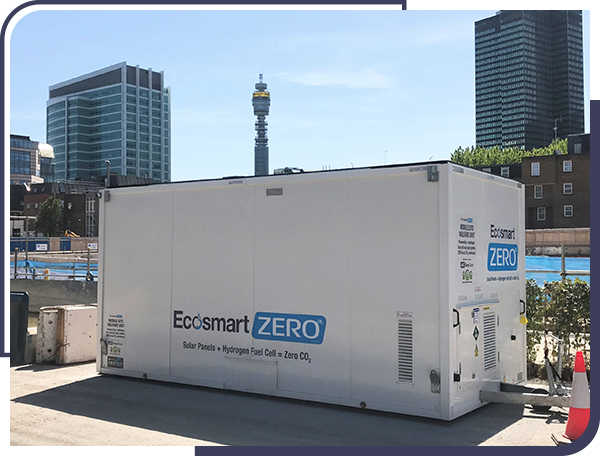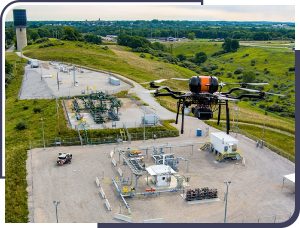Tinius Olsen Helps Drive Sustainability Through Hydrogen Fuel Cell Technology Testing
Over the past few years, the UK government has made significant strides in advancing its hydrogen economy. Tinius Olsen is currently supporting this initiative alongside the UK’s leading developer of hydrogen fuel cell technology, Intelligent Energy.
According to the UK’s Department for Energy Security & Net Zero, “Hydrogen has a critical role in helping to achieve our Clean Energy Superpower Mission. It can provide flexible low carbon power generation, meaning we can use hydrogen to produce electricity during extended periods of low renewable output.”
How Hydrogen Cells Work
Fuel cells themselves work like batteries, but they do not run down or need recharging and they produce electricity and heat as long as fuel is supplied. The unit consists of two electrodes—a negative electrode (or anode) and a positive electrode (or cathode)—sandwiched around an electrolyte.
A fuel, such as hydrogen, is fed to the anode and air is fed to the cathode. In a hydrogen fuel cell, a catalyst at the anode separates hydrogen molecules into protons and electrons, which take different paths to the cathode. The electrons go through an external circuit, creating a flow of electricity, whereas the protons migrate through the electrolyte to the cathode, where they unite with oxygen and the electrons to produce water vapor and heat.
“It’s an intrinsically simple system, but highly efficient and of course extremely green, producing only water vapor out of the exhaust pipe, so to speak, and doesn’t rely on electricity from the National Grid,” said Oliver Jackson, senior research engineer at Intelligent Energy based in Loughborough, the UK’s leading developer of hydrogen fuel cell technology. (Figure 1)

Innovations in Using Electric Energy
“The technology can be applied across a broad range of uses too, such as the aerospace industry, with the eventual aim of replacing fossil fuel powered jet engines with electrically powered alternatives now becoming increasingly realistic. It’s really exciting stuff.”
In 2001, Intelligent Energy emerged as a spin out from Loughborough University, where the first fuel cell project began in 1988. More than two decades later, following collaborations with the likes of Suzuki, Airbus, Boeing and also BMW, the company now employs 250 people. It has partners and customers around the globe, delivering a range of zero-emission hydrogen fuel cell products to the automotive, aerospace, power generation, telecoms, marine, rail, UAV and materials handling industries.
“What we recognize as the first hydrogen fuel cell was developed by Welshman William Grove in 1838, with the modern electric battery invented by Alessandro Volta some forty-two years earlier,” noted Jackson.
“Hydrogen fuel cell technology has come a long way in just the last 35 years or so. Our collaborations with major global companies have made a huge contribution here and these market forces are continuing to drive things forward. Reaching net zero is obviously the main consideration, as well as reducing the cost, but the industry needs lighter, cheaper and even more efficient fuel cells to help achieve these targets – this is now our biggest challenge.”
Testing for More than Just Quality Control
This puts materials testing at the forefront of R&D, because if lighter or cheaper materials are proven to work just as well, after a rigorous and extensive testing program, then these results can be built into the bottom line, creating a more cost effective, viable option. (Figure 2)

“Our own in-house research team is intensively using Tinius Olsen’s equipment to test materials for mechanical properties, tensile, compressive and bending strength, stiffness…you name it. If we’re going to get a finer material at a much lighter weight, we need to make sure it’s strong and durable enough for its intended purpose.”
“We test a number of other aspects in the testing lab, too, such as electrical resistance, testing of coatings and even the transport properties of materials, including the carbon papers we use for our gas diffusion. For all these things, we need to be applying different forces to see how these properties change at different pressures, and so on.”
“We do quite a lot of testing on things like gaskets and seals as well as supporting other departments across the business, including the mechanical design team that needs to test new designs and prototypes. Material properties data is used by our modeling, quality and production teams to test batch variability of products and defect analysis.” (Figure 3)

Materials Testing Moves the Industry Forward
“All in all, the Tinius Olsen systems and support we receive is fundamental to what we do, so you could say they’re very much on the front line of these developments, generating confidence in the materials used and the finished product.”
“Customers can only be as confident in your products as you are, so the more testing you undertake, the more you trust your work, and the more willing you are to supply customers and not have to worry. If the product isn’t to specification, then it’s obviously going to be sent back, resulting in increased support to get it to work as expected. So, we want to get it right the first time and continually improve, so that the customer’s performance continues to get better.
Intelligent Energy is continuing its development of hydrogen fuel cell technology at a rapid pace. In fact, with major automotive manufacturers such as BMW and Toyota actively producing their own hydrogen powered cars, IE’s work could well see this technology competing with, if not replacing, the current battery powered options.



